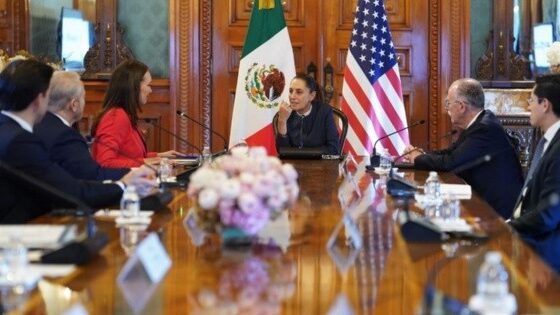The head of the Ministry of Agriculture and Rural Development (Sader), Julio Berdegué, and the secretary of the United States Department of Agriculture (USDA), Brooke Rollins, reviewed the progress of the joint campaign of neighboring nations against the cattle screwworm, and defined some actions that will allow the reopening of the border for export.
Through a statement, Sader indicated that officials from both countries “verified the progress of the joint campaign against the cattle screwworm (GBG).”
Later, Rollins was received at the National Palace by President Claudia Sheinbaum and “in a respectful, cordial and productive meeting” progress in technical and commercial cooperation in the agri-food sector was reviewed, as well as other matters of mutual interest.
Review: Harfuch rules out evidence of links between Manzo’s bodyguards and organized crime
“During the meeting, the reopening of the border to the export of livestock was highlighted as a priority for the Government of Mexico,” said a statement and both countries “reaffirmed their commitment to combating the cattle screwworm, facilitating agricultural trade and protecting animal health in North America.”
Previously, both secretaries had agreed on “short-term priorities and actions that will allow decisions to be made on the resumption of livestock exports.”
Among the main topics discussed, the strengthening of coordination around the GBG and other animal health issues stands out, as well as the identification of areas of collaboration within the framework of the next review of the Treaty between Mexico, the United States and Canada (T-MEC), the note noted.
The parties have not yet referred to a possible agreement between both countries to open the border for the export of livestock, closed for the first time since November last year.
You may be interested: Sheinbaum rules out changes in security after the murder of the mayor of Uruapan
Strong integration
Berdegué stressed the importance of “maintaining trust, certainty and respect for the rules” as principles that drive the development of solid agri-food integration between the three North American countries.
“Mexico seeks more trade, more integration and more cooperation, for the benefit of producers and consumers”said the head of Sader. Both secretaries also discussed the opportunities for agri-food trade between Mexico and the US.
Rollins’ visit occurs amid trade tensions arising from the lack of agreement between Mexico and the United States to reopen the border to livestock imports, partially frozen for almost a year due to the outbreak of the screwworm fly.
Livestock imports from Mexico play an important role in the US, averaging more than one million head annually for decades, representing approximately 60% of live cattle imports and about 3% of the national herd.
This makes Mexico one of the main suppliers of live cattle to the United States.
Until now, the Mexican sector has estimated losses of 1.3 billion dollars, according to data from the National Agricultural Council (CNA), which has reported the interruption of shipping to the United States of at least 650 thousand heads of cattle due to the closure generated by the proliferation of the worm in the Mexican southeast.
The dialogue between both Governments is also part of the broader talks on economic and agricultural cooperation promoted within the T-MEC, with the aim of strengthening production chains and guaranteeing free agri-food trade in the region.
Read also: This is what Carlos Manzo’s complaints were like before his murder
* * * Stay up to date with the news, join our whatsapp channel * * *
MB

